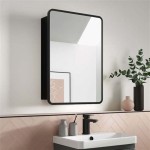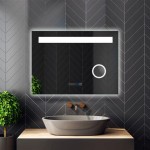Gothic Arch Mirrors: An Exploration of History, Design, and Application
Gothic arch mirrors represent a compelling fusion of historical architectural influence and contemporary design sensibilities. These mirrors, characterized by their pointed, arch-shaped frames, evoke a sense of grandeur, sophistication, and timeless elegance. Their distinctive silhouette departs from the more common rectangular or circular mirror formats, offering a statement piece that can significantly transform the aesthetic of any space. Understanding the origins, design principles, and practical applications of gothic arch mirrors is crucial for appreciating their enduring appeal and effectively incorporating them into interior design schemes.
The gothic arch, also known as the pointed arch or ogival arch, is a defining feature of Gothic architecture, a style that flourished in Europe during the High and Late Middle Ages (roughly 12th to 16th centuries). Cathedrals, castles, and other significant structures of this period often showcased impressive pointed arches, which were not only visually striking but also structurally efficient. The arch’s pointed shape allowed for greater height and larger window openings without compromising structural integrity. This innovation led to the soaring spaces and abundant natural light that are hallmarks of Gothic architecture.
The adoption of the gothic arch motif in mirror design represents a direct borrowing of this architectural element for decorative purposes. While gothic arch mirrors do not necessarily replicate the structural function of their architectural counterparts, they capture the visual essence of the style. The pointed arch shape, when applied to a mirror frame, immediately imbues the object with a sense of history, artistry, and a connection to a specific aesthetic movement.
The Historical Context and Evolution of the Gothic Arch
The origins of the gothic arch can be traced back to earlier architectural styles, including Islamic architecture, which employed pointed arches in various building designs. However, it was during the Gothic period that the pointed arch achieved its full potential, becoming a defining characteristic of the style. The structural advantages of the pointed arch, coupled with its aesthetic appeal, led to its widespread adoption in ecclesiastical and secular architecture.
The use of pointed arches allowed builders to create taller and more spacious structures compared to the rounded arches of Romanesque architecture. The pointed arch distributes weight more efficiently, reducing the lateral thrust on the supporting walls. This, in turn, enabled the construction of thinner walls and larger window openings, allowing for more natural light to flood the interior spaces. Stained glass windows, another prominent feature of Gothic architecture, were often integrated within pointed arch frames, creating stunning visual effects.
As the Gothic style evolved, the pointed arch became increasingly elaborate and refined. Ornate tracery, rib vaults, and flying buttresses were incorporated to enhance the visual complexity and structural stability of Gothic structures. The overall effect was one of soaring verticality, intricate detail, and dramatic illumination. The gothic arch, therefore, became synonymous with aspirations of reaching towards the divine and expressing the grandeur of religious and secular power.
The resurgence of interest in Gothic architecture in later periods, such as the Gothic Revival movement of the 18th and 19th centuries, led to the renewed appreciation and application of the gothic arch in various decorative arts, including furniture and mirror design. Gothic arch mirrors, in this context, became a way to incorporate the historical and aesthetic significance of the Gothic style into the domestic environment.
Design Considerations and Materials
The design of a gothic arch mirror involves several key considerations, including the proportions of the arch, the material and finish of the frame, and the overall style of the mirror. The arch itself can vary in its steepness and curvature, ranging from a relatively shallow pointed arch to a more elongated and dramatic shape. The choice of arch shape will influence the overall aesthetic of the mirror and its suitability for different spaces.
The material used for the frame is another important factor. Wood is a common choice, offering versatility in terms of design and finish. Wood frames can be stained, painted, or distressed to achieve a variety of looks, from rustic and antique to sleek and modern. Metal frames, such as wrought iron or brass, can also be used to create gothic arch mirrors. Metal frames often evoke a sense of strength and durability, and they can be particularly well-suited for industrial or vintage-inspired interiors.
The finish of the frame is also critical to the overall design. A distressed or antique finish can enhance the historical character of the mirror, while a polished or lacquered finish can create a more contemporary look. Decorative details, such as carvings, moldings, or metal accents, can further enhance the visual appeal of the mirror frame. Some gothic arch mirrors incorporate stained glass panels or decorative inlays, adding another layer of artistry and complexity to the design.
The glass itself is another essential component. While standard mirror glass is commonly used, some designs incorporate beveled edges or antique mirror glass to add visual interest and depth. The size of the mirror is also a significant consideration, depending on the intended application. Smaller gothic arch mirrors can be used as decorative accents, while larger mirrors can serve as focal points in a room, creating the illusion of more space and reflecting light.
Applications in Interior Design and Styling
Gothic arch mirrors can be effectively incorporated into a wide range of interior design styles, from traditional and historical to modern and eclectic. Their versatility lies in their ability to complement various color palettes, textures, and furniture styles. In traditional interiors, gothic arch mirrors can enhance the existing sense of history and elegance. They can be paired with antique furniture, ornate lighting fixtures, and rich fabrics to create a cohesive and visually striking space.
In more modern interiors, gothic arch mirrors can serve as unexpected and eye-catching focal points. Their unique shape and historical association contrast with the clean lines and minimalist aesthetic of contemporary design, creating a sense of visual tension and interest. They can be used to add a touch of drama and sophistication to otherwise simple and understated spaces. Pairing a gothic arch mirror with modern furniture in neutral colors can create a balanced and stylish look.
Gothic arch mirrors are particularly well-suited for entryways, hallways, and living rooms. In entryways, they can create a welcoming and impressive first impression. In hallways, they can visually expand the space and reflect light, making the area feel brighter and more open. In living rooms, they can serve as a statement piece above a fireplace, console table, or sofa, adding a touch of architectural interest and visual depth.
The placement of the mirror is also crucial to its effectiveness. Consider the surrounding elements, such as the wall color, lighting, and furniture arrangement. Position the mirror to reflect natural light or a visually appealing view, maximizing its impact on the overall space. A gothic arch mirror can also be used to create a sense of symmetry and balance in a room. Placing two identical mirrors on either side of a focal point, such as a fireplace or doorway, can create a visually harmonious and balanced composition.
Beyond their aesthetic appeal, gothic arch mirrors can also serve practical purposes. They can be used to create the illusion of more space, particularly in small or cramped rooms. By reflecting light and creating visual depth, mirrors can make a room feel larger and more open. They can also be used to conceal architectural flaws or unattractive features, drawing attention away from those areas and focusing on the more visually appealing aspects of the space.
In conclusion, the gothic arch mirror represents a compelling and versatile design element that can enhance the aesthetic of any space. Its historical roots, distinctive shape, and adaptable design make it a timeless and enduring choice for interior design. By carefully considering the design principles, materials, and applications of gothic arch mirrors, one can effectively incorporate them into a wide range of interior styles, creating spaces that are both visually striking and functionally appealing.

Truncated Gothic Arch Ornate Mirror

Gothic Arched Window Mirrors Set Of 2 For At Pamono

Gothic Arched Indoor Outdoor Full Length Wall Mirror Dunelm

Beautiful Gothic Church Arch Overmantel Mirror

Buy Gothic Arch Window Wall Mirror At 20 Off Retail Staunton And Henry

Gothic Arch Large Garden Mirror 190cm X 75cm Mirrors Exclusive

Small Lancet Arch Gothic Mirror

Gothic Arched Mirror Small Ferailles

Gothic Arch Window Mirror 110cm Metal Frame Home Wall Modern Living Hallway Deco

Gothic Arch Window Mirror 70cm Black Home Wall Modern Living Hallway Decoration








